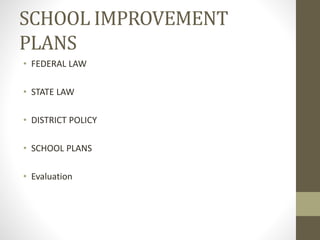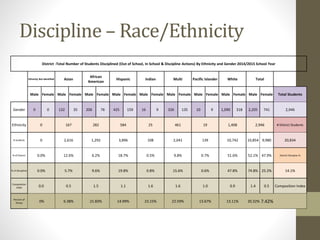Improvement through the use of data 2015
- 1. Improvement Through the Use of DATA School Improvement Planning
- 2. Patrick Murphy • Assistant Superintendent Edmonds School District • Former Executive Director of Secondary Schools in Issaquah School District • Middle School Principal • High School Assistant Principal • Junior High Assistant Principal • Social Studies and Language Arts Teacher Introduction – What you do and why you are considering becoming an educational administrator?
- 3. What’s The Purpose of School • Brainstorm? (Capture Ideas)
- 4. WHY MAKE A SIP? • Turn and Talk?
- 5. Federal-Title 1— ImprovingThe Academic AchievementOf The Disadvantaged • PRIORITY- The State educational agency, in allocating funds to local educational agencies under this section, shall give priority to local educational agencies that — • (1) serve the lowest-achieving schools; • (2) demonstrate the greatest need for such funds; and • (3) demonstrate the strongest commitment to ensuring that such funds are used to enable the lowest-achieving schools to meet the progress goals in school improvement plans under section 1116 (b)(3)(A)(v).
- 6. STATE - WAC 180-16-220 • Evidence and date of annual school board approval. • • Evidence staff certification requirements were met. • • Evidence the plan is based on self-review and participation of required participants (staff, students, families, parents, and community members). • • Brief summary of use of data to establish improvement. • • Plan promotes continuous improvement in student achievement of state learning goals and essential academic learning requirements (EALRs). • • Recognition of non-academic student learning, what, and how. • • Plan addresses characteristics of successful schools. • • Plan addresses educational equity (gender, race, ethnicity, culture, language, and physical/mental ability). • • Plan addresses use of technology to facilitate instruction. • • Plan addresses parent, family, and community involvement
- 7. CharacteristicsofHigh PerformingSchool Districts • 1. District-Wide Focus on Student Achievement • 2. Approaches to Curriculum and Instruction • 3. Use of Evidence for Planning, Organizational Learning, and Accountability • 4. District-Wide Sense of Efficacy • 5. Building and Maintaining Good Relations • 6. Investing in Instructional Leadership • 7. Targeted and Phased Focuses for School Improvement • 8. District-Wide, Job-Embedded Professional Development for Leaders and Teachers • 9. Strategic Engagement with the Government’s Agenda for Change and Associated Resources • 10. Infrastructure Alignment Leithwood(2008)
- 8. Nine Characteristics of High Performing Schools • A clear and shared focus • High standards and expectations for all students • Effective school leadership • High levels of collaboration and communication • Curriculum, instruction and assessments aligned with state standards • Frequent monitoring of learning and teaching • Focused professional development • A supportive learning environment • High levels of family and community involvement OSPI(2007)
- 9. Now that you Know Your Goals •How Do You Measure IT?
- 10. What do We Do in Edmonds?
- 11. • Effective Learning for All Students Each student is engaged in meaningful and relevant learning, every day. We provide comprehensive educational programs and a wide variety of activities that build a solid foundation of knowledge and skills, encourage mindful higher- level thinking, and inspire all students to pursue their interests. • Equity of Opportunity Each student experiences a diverse, inclusive culture where all people are valued. Adults work to meet students’ individual needs and remove institutional and social barriers to their personal success. Our StrategicDirection(Our ‘True North’)
- 12. • P – 3rd Grade Early Learning Each student has a supportive, equitable educational foundation and is on track to be performing at grade level by third grade. We work closely with families and community partners to connect and align our schools with local resources to maximize early learning. • Graduates Who Are Ready for Life Each student is equipped with the knowledge and skills needed to be resilient, participating citizens who are prepared to pursue and accomplish educational, life, and work-related interests after high school. Our Strategic Direction (Our ‘True North’)
- 13. SCHOOL IMPROVEMENT PLANS • FEDERAL LAW • STATE LAW • DISTRICT POLICY • SCHOOL PLANS • Evaluation
- 15. • Will drive and inform board reports by Supt. Staff • Will drive and inform conversations around SIP’s between principals and Asst. Supts. • Will drive and inform the SD Work Groups Strategic Direction Indicators
- 16. BASELINE DATA Who is and is not being successful?
- 17. 67% 79% 41% 38% 27% 68% 60% 67% 75% 41% 30% 55% 59% 54% 0% 10% 20% 30% 40% 50% 60% 70% 80% 90% 100% American Indian/Alaskan Native Asian Black Hispanic Native Hawaiian/Other Pacific Islander White Two or More Races SBA 7th Grade Reading and Math 2014-2015: by Race/Ethnicity Reading 2014-2015 Math 2014-2015 Achievement – SBA 7th grade – Reading and Math by Race/Ethnicity – 2014-2015
- 18. Student Demographics Staff Demographics 2008 2009 2010 2011 2012 2013 2014 2015 % change 2013 2014 2015 Total Enrollment 20905 20743 20609 20659 20613 20728 20743 20834 -0.3% American Indian 1.4 1.5 1.4 0.9 0.7 0.6 0.5 0.5 -64.3% 0.94 0.95 0.9 Asian 14.4 14.6 14.6 13.6 13.6 13.3 13.1 12.6 -12.5% 4.48 4.73 4.54 Black 6.2 6.1 5.9 5.7 5.7 5.8 6.2 6.2 0.0% 1.51 1.67 1.68 Hispanic 9.8 10.5 9.7 14.8 15.8 16.6 17.6 19.8 102.0% 1.79 1.87 2.55 Native Hawaiian/O ther Pacific Islander 0.5 0.7 0.8 0.7 0.7 0.6 0.6 0.7 40.0% 0.04 0.04 0.08 White 65.8 63.5 59.4 56.2 54.8 53.7 52.3 51.6 -21.6% 91.11 90.77 89.66 Two or More 8.1 8.8 9.4 9.7 9.8 21.0% 0.12 0.64 0.47 Free/Reduc ed Lunch 26.9 28.9 30.8 35.1 37.2 36.6 34.4 27.9% Special Education 13.2 13.3 13.2 13.6 13.8 14.2 14.2 7.6% Transitional Bilingual 8.7 9.3 10 10.1 9.6 10.2 11.3 29.9% *Source:OSPI&ESDHuman Resources Student Enrollment and Staffing
- 19. Hispanic Indian Asian Black/African American Pacific Islander White Multi- Racial SPED ELL Low Income Total Number 10443 623 1738 2045 427 19175 3512 10244 4287 25411 38887 Percent 27% 2% 4% 5% 1% 49% 9% 26% 11% 65% 100% Attendance NumberandPercentageofUnexcusedAbsencesin 2014-15
- 20. 84.7 72.0 77.9 74.5 53.1 52.9 83.8 76.1 77.0 59.5 55.8 40.0 80.2 77.7 78.1 76.9 57.1 50.0 90.2 87.1 84.2 82.2 64.8 46.2 0 10 20 30 40 50 60 70 80 90 100 Asian Two or More Races White Black/African American Hispanic/Latino American Indian/Alaskan Native Edmonds - Race/Ethnicity Groups Adjusted 4-Year Cohort Graduation Rates 2011 2012 2013 2014 Districts with fewer than 10 students in the group are not displayed. Graduation Data by Race/Ethnicity
- 21. 0 10 20 30 40 50 60 70 80 90 100 2004 2005 2006 2007 2008 2009 2010 2011 2012 2013 Percent High School Graduation Year College Direct by Ethnicity: Edmonds School District White Black Asian Hispanic Native American/Alaskan Native Ethnicity not reported if n < 10. College Direct Rates
- 22. District -Total Number of Students Disciplined (Out of School, In School & Discipline Actions) By Ethnicity and Gender 2014/2015 School Year Ethnicity Not identified Asian African American Hispanic Indian Multi Pacific Islander White Total Male Female Male Female Male Female Male Female Male Female Male Female Male Female Male Female Male Female Total Students Gender 0 0 132 35 206 76 425 159 16 9 326 135 10 9 1,090 318 2,205 741 2,946 Ethnicity 0 167 282 584 25 461 19 1,408 2,946 # District Students # students 0 2,616 1,292 3,896 108 2,041 139 10,742 10,854 9,980 20,834 % of District 0.0% 12.6% 6.2% 18.7% 0.5% 9.8% 0.7% 51.6% 52.1% 47.9% District Discipine % % of Discipline 0.0% 5.7% 9.6% 19.8% 0.8% 15.6% 0.6% 47.8% 74.8% 25.2% 14.1% Composition Index 0.0 0.5 1.5 1.1 1.6 1.6 1.0 0.9 1.4 0.5 Composition Index Percent of Group 0% 6.38% 21.83% 14.99% 23.15% 22.59% 13.67% 13.11% 20.32% 7.42% Discipline – Race/Ethnicity
- 23. 35% of students are on free and reduced lunch, but those students make up 66% of discipline incidents. Income Breakdown
- 24. Malesmakeupabout50%of thestudentpopulation,but theymakeup80%of disciplineincidents. Females make up about 50% of the student population, but they are involved in only 20% of discipline incidents. Gender Breakdown
- 25. 13% of students are in special education, but SPED students make up 34% of discipline incidents. SPED Breakdown
- 26. • GUIDING PRINCIPLE 2: CLEAR, APPROPRIATE, AND CONSISTENT EXPECTATIONS AND CONSEQUENCES • Schools that have discipline policies or codes of conduct with clear, appropriate, and consistently applied expectations and consequences will help students improve behavior, increase engagement, and boost achievement. • 1. Each secondary school should have a designated space and staff resource to implement an In- school suspension program to replace currently assigned out of school suspensions. In those instances of non-violent transgressions, or ones that do not pose a safety risk to staff or students, in-school suspension should be the preferred alternative to out of school. • 2. The school district should produce a “district” student handbook that lists consistent definitions of behavior violations and expected consequences. The district handbook will be a key measure in ensuring equity of application of discipline across schools. • 3. After school detention and community service should be a first option for non-violent, non- safety behavior violations. They should be educational in nature and help students feel more connected to their school and community. Parents should always be notified prior to such assignment to help better ensure attendance and prevent greater consequences. • 4. Truancy and attendance related violations should never result in suspension. • 5. Suspension should be recognized as the disciplinary measure “of last resort” and should only be used in cases of safety matters or substantial disruption to the educational environment. EdmondsSchoolDistrict AlternativestoSuspensionCommittee FINALRECCOMENDATIONS
- 27. Mid Year Discipline Data # of Occurences 2013-14 2014-15 % Change Middle School 09-04-13 to 01-30-14 9/3/2014 to 01-30-15 EE 19 34 -79% EX 0 0 0% LT 14 19 -36% ST 143 64 55% TOTAL 176 117 34% High School 09-04-13 to 01-30-14 9/3/2014 to 01-30-15 EE 107 112 -5% EX 6 7 -17% LT 82 69 16% ST 240 143 40% TOTAL 435 331 24% # of Students 2013-14 2014-15 Middle School 09-04-13 to 01-30-14 9/3/2014 to 01-30-15 EE 17 27 -59% EX 0 0 0% LT 14 19 -36% ST 108 51 53% TOTAL 139 97 30% High School 09-04-13 to 01-30-14 9/3/2014 to 01-30-15 EE 97 101 -4% EX 6 7 -17% LT 82 69 16% ST 171 111 35% TOTAL 356 288 19%
- 28. Edmonds 7010 - School Improvement Plans for Principals and Instructional Managers • It is the policy of the Edmonds School District to require each school to develop and adopt a school improvement plan that includes an annual review process. Each school shall submit its plan to the Edmonds School Board by October 1 of each year for initial approval and annual review. • Each school improvement plan shall reflect the use of student performance data and shall promote a positive impact on student learning. (A positive impact on student learning means promoting the continuous achievement of the state learning goals and essential academic learning requirements, and the achievement of nonacademic growth in areas like public speaking, leadership, interpersonal relationship skills, team work, self-confidence and resiliency, so that students can meet the goals of Washington's basic education system: to become responsible citizens, to contribute to their own economic well- being and that of their families and communities, and to enjoy productive and satisfying lives.) • Each school improvement plan shall be based on a building self-review that includes the active participation and input of building staff, students, parents, and community members.
- 29. Puyallup Policy 2010 • School Improvement Planning • School improvement planning is the process schools use to ensure that all students are achieving at high levels. All schools can become better environments so that more students are successful. Annual yearly progress of public schools is essential in providing increased student performance and quality results. Innovative and research- based programs, coupled with staff development, focused and aligned resources, and public participation in planning, are critical factors in improving schools. • The Comprehensive School Improvement Plan developed by each team shall be reviewed by the building principal before being submitted to their Executive Directors of Elementary Education or Secondary Education. If the principal does not approve the plan, he or she shall work with the CSIP Team until consensus is achieved. The Executive Directors may refer a plan back to the CSIP Team with recommendations for change. When approved, the plan shall be monitored and reviewed on an ongoing basis by the principal in collaboration with staff. The plan will also be reviewed periodically with the Executive Directors and other members of the K-12 Education Department.
- 30. Edmonds Template Does it meet or have the potential to meet the state criteria (WAC)? Will this result in improved student learning?
- 31. Principal Evaluation-AWSP Framework • Criterion 3 | Planning with Data Leading the development, implementation and evaluation of a data-driven plan for increasing student achievement, including the use of multiple student data elements.
- 32. Planning with Data 3.1Recognizes and seeks out multiple data sources 3.2 Analyzes and interprets multiple data sources to inform school- level improvement efforts 3.3Implements data driven plan for improved teaching and learning 3.4Assists staff to use data to guide, modify and improve classroom teaching and student learning 3.5Provides evidence of student growth that results from the school improvement planning process* *Student Growth Scoring Area
- 33. 3.1Recognizes and seeks out multiple data sources • Systematically collects valid and reliable data from at least three sources to be used in problem solving and decision making; builds capacity of staff to recognize information as data by providing examples of using data throughout the building and in staff meetings; systematically gathers data on grades, attendance, behavior and other variables to inform efforts
- 34. 3.2 Analyzes and interprets multiple data sources to inform school-level improvement efforts Analysis includes multiple years of data, including state, district, school and formal and informal classroom assessments; interprets available data to make informed decisions about strengths and areas of need; provides teacher teams with previous year’s data and asks them to assess students’ current needs .
- 35. 3.3Implements data driven plan for improved teaching and learning • Provides leadership such that plan is clearly articulated and includes action steps and progress monitoring strategies, and strategies in the plan are directly aligned with the data analysis process and are research based; leads ongoing review of progress and results to make timely adjustments to the plan; data insights are regularly the subject of faculty meetings and professional development sessions
- 36. 3.4 Assists staff to use data to guide, modify and improve classroomteaching and student learning Regularly assists staff to use multiple types of data to reflect on effectiveness of lessons, guide lesson and assessment development, differentiate instruction (highly achieving as well as non-proficient) and to determine whether re-teaching, practice or moving forward with instruction is appropriate at both the group and individual level; strategies result in clear relationship between the actions of teachers and the impact on student achievement
- 37. 3.5Providesevidenceof student growth that resultsfrom the school improvement planning process* School improvement planning process results in measurable improvement in student academic growth
- 38. School Improvement • It’s a process, not an event • Should not be an exercise in compliance • We don’t finish the “SIP” so we can get back to the “real work”. It IS the work. • It can’t just sit on a shelf • If anyone asks you what your school is all about and you do not reference your school improvement plan, something is not right. • It should tie together all the work you are doing in school – to dispel this idea that there are too many initiatives and they are not connected
- 39. Thank you!







































